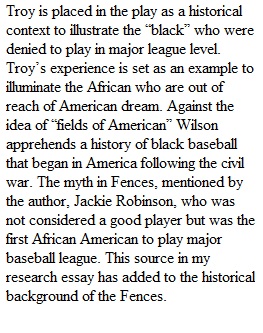


Q tions Purpose: Practice analyzing, evaluating, and synthesizing sources in preparation for your Final Project Researched Essay, which will entail taking one of your essays from Units 2, 3, or 4 and revising it to become a researched essay incorporating one of the theories of literary criticism we studied in Unit 1 (excluding Reader Response). You will start this process by creating an annotated bibliography with one well-chosen source. Tasks: Locate one scholarly source that would help analyze Fences. This source can include literary criticism and/or a scholarly article about Fences. Seek help (from one of the embedded librarians or your professor) with locating sources, particularly if you are struggling to locate a scholarly source. For example, you might search for articles about the color barrier in baseball, flower symbolism in literature, blues songs, maternal mortality in childbirth, black male incarceration, racial discrimination in 1950s Pittsburgh, etc. (This list is just a brainstorm and it is by no means complete. Think of your own--what aspects of the play intrigue you, puzzled you, or related to your own interests?) Now, you will write an individual annotated bibliographic entry for this source. Complete the following: Begin with the MLA works cited entry for the text. Note that EbscoHost (in Galileo) will provide you with the MLA citation if you click “Cite” on the right-hand panel [and, scroll to the MLA entry]. And, also note that the works cited entry for the “Student-Selected Scholarly Articles” has been provided, in the “description” section (below the article’s title). If you use a "Cite" button-generated citation, be sure to double-check the citation to ensure it is correctly formatted. This link shows you what a correct MLA 8th edition entry for a journal article found in a database should look like: http://www.easybib.com/guides/citation-guides/mla-8/cite-journal-article-online-database-mla-8/ Then, write one well-developed paragraph that summarizes, synthesizes, and reflects on the source, using the outline below. Make sure that the paragraph contains specific information (not general observations that could apply to any source). Note that a single quote may be included—but the quote must be no more than one (fully) typed line. Write 2-3 sentences that summarize the source’s main argument and claims; be specific when summarizing the text and include parenthetical citations when appropriate. Write 2-3 sentences that evaluate what evidence and examples the source uses to support its main focus/claims. Briefly explain the source’s merits—and/or deficiencies—in terms of logic, persuasion, credibility, etc. Consider whether the author(s) effectively presented her/his/their claims—and how. Keep in mind that your evaluation does not need to be only positive or negative; the source may be adept in certain areas, but not in others. Write 2-3 sentences that reflect on how you might use the article/source in your researched essay. Consider what new information you learned—and how the source “added” to the ongoing conversation about your topic. It may be helpful to imagine the author as a participant in an online discussion on the poem—what would she/he “say”? For reference, consult these resources: Sample MLA annotations [note that this paragraph does not include the “reflection” information]; and Purdue OWL’s explanation of an annotated bibliography. Submission Criteria (points may be deducted for not following these guidelines): Upload your bibliography to the submission folder by the due date given by your instructor. On the first page of your assignment, include your name, date, and assignment name. Grading Criteria: One scholarly article from Galileo or other scholarly source; you may include additional sources if you like. Developed paragraphs that engage specific ideas in the texts (not general observations) for the distinct purposes of analysis, evaluation, and synthesis Clear, grammatically correct prose. Correct MLA guidelines for citations.
View Related Questions